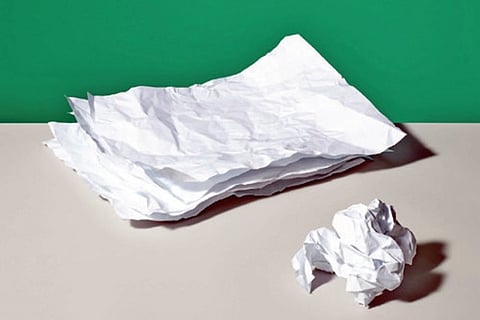

Chennai
In a sense, creases happen when a thin sheet of material gets claustrophobia. “New creases form if a sheet doesn’t comfortably fit into its confined area,” said Jovana Andrejevi, a Ph.D. student in applied physics at Harvard and the lead author of a new paper detailing the latest advances in paper crumpling. “The sheet is stressed, so something needs to happen to relieve that stress,” Andrejevi said. She was speaking from her childhood home outside Chicago, where she is living temporarily with her parents and her twin sister, Nina, who is pursuing a Ph.D. in materials science at the Massachusetts Institute of Technology. “The formation of a crease is how the stress is relieved,” Andrejevi said. “The role of the creases is effectively to protect as much of the sheet as possible from further damage.”
Those protected areas — the “facets” — and how they break into smaller and smaller fragments when recrumpled are the focus of the new study. Published on Friday in Nature Communications, the investigation builds on a 2018 study by some of the same researchers. The earlier study showed how paper crumpling — a seemingly random, disordered and complex process — displays a surprising amount of mathematical order. This result represented “a remarkable reduction in complexity,” the researchers noted in their 2018 paper.
Crumpled paper is a proxy for much more than our pandemic angst. Similar dynamics are at play, for instance, in the wrinkling of graphene sheets for high-performance batteries; the flexibility of wearable electronic devices and artificial skin, and the folding of Earth’s crust. The 2018 study showed that the cumulative total length of all creases — the “mileage” — on a crumpled sheet served as a predictor of how the sheet would behave when crumpled again and again.
Although the researchers crumpled a sheet as many as 70 times, after a few cycles it was difficult to see any difference, from one crumple to the next. But by tracking and analysing the mileage, they noticed that a sheet never stopped forming creases, although it did so at a logarithmic rate, adding fewer creases with each recrumpling.
“It is a beautiful contribution,” said Jean-François Molinari, an engineer at the Swiss Federal Institute of Technology Lausanne whose recent research focuses on friction and fracture. “The analogy to fragmentation is quite creative. This is what physics is all about: finding simplicity in complex patterns, and finding analogies between seemingly disconnected fields.” Rycroft’s group studies bulk metallic glasses, or B.M.G.s — materials composed of atoms with a structure that is random and amorphous rather than orderly and crystalline. The disorder lends itself to high-strength and wear-resistant properties, which could benefit a wide range of applications, from smartphone cases to aircraft components.
Siobhan Roberts is a journalist with NYT
The New York Times
Visit news.dtnext.in to explore our interactive epaper!
Download the DT Next app for more exciting features!
Click here for iOS
Click here for Android